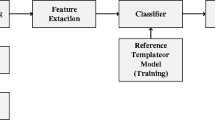Abstract
Biometric traits offer direct solutions to the critical security concerns involved in identity authentication systems. In this paper, a systematic analysis of the electrocardiogram (ECG) signal for application in human recognition is reported, suggesting that cardiac electrical activity is highly personalized in a population. Features extracted from the autocorrelation of healthy ECG signals embed considerable diacritical power, and render fiducial detection unnecessary. The central consideration of this paper is the evaluation of an identification system that is robust to common cardiac irregularities such as premature ventricular contraction (PVC) and atrial premature contraction (APC). Criteria concerning the power distribution and complexity of ECG signals are defined to bring to light abnormal ECG recordings, which are not employable for identification. Experimental results indicate a recognition rate of 96.2% and render identification based on ECG signals rather promising.
Similar content being viewed by others
References
Jain A.K., Ross A., Prabhakar S.: An introduction to biometric systems. IEEE Trans Circuit Syst Video Technol 14(1), 4–20 (2004)
Biel L., Pettersson O., Philipson L., Wide P.: ECG analysis: a new approach in human identification. IEEE Trans Instrum Meas 50(3), 808–812 (2001)
Israel S.A., Irvine J.M., Cheng A., Wiederhold M.D., Wiederhold B.K.: ECG to identify individuals. Pattern Recognit 38(1), 133–142 (2005)
Israel, S.A., Scruggs, W.T., Worek, W.J., Irvine, J.M.: Fusing face and ECG for personal identification. In: Proceedings of 32nd Applied Imagery Pattern Recognition workshop, pp. 226–231. (2003)
Shen, T.W., Tompkins, W.J., Hu, Y.H.: One-lead ECG for identity verification. In: Proceedings of the 2nd Conference of the IEEE Engineering in Medicine and Biology Society and the Biomedical Engineering Society, vol. 1, pp. 62–63. (2002)
Shen, T., Tompkins, W.: Biometric statistical study of one-lead ECG features and body mass index (BMI). In: Engineering in Medicine and Biology Society. 27th Annual International Conference, pp. 1162–1165. (2005)
Wang, Y., Plataniotis, K.N., Hatzinakos, D.: Integrating analytic and appearance attributes for human identification from ECG signal. In: Proceedings of Biometrics Symposiums (BSYM), Baltimore, September 2006
Martinez J., Almeida R., Olmos S., Rocha A., Laguna P.: A wavelet-based ECG delineator: Evaluation on standard databases. IEEE Trans Biomed Eng 51(4), 570–581 (2004)
Green L., Lux R., Williams C.H.R., Hunt S., Burgess M.: Effects of age, sex, and body habitus on QRS and ST-T potential maps of 1100 normal subjects. Circulation 85, 244–253 (1985)
Draper H., Peffer C., Stallmann F., Littmann D., Pipberger H.: The corrected orthogonal electrocardiogram and vectorcardiogram in 510 normal men (frank lead system). Circulation 30, 853–864 (1964)
Pilkington T., Barr R., Rogers C.L.: Effect of conductivity interfaces in electrocardiography, vol. 30, pp. 637–643. Springer, New York (2006)
Larkin H., Hunyor S.: Precordial voltage variation in the normal electrocardiogram. J Electrocardiol 13, 347–352 (1980)
Kozmann G., Lux R., Green L.: Sources of variability in normal body surface potential maps. Circulation 17, 1077–1083 (1989)
Kozmann G., Lux R., Green L.: Geometrical factors affecting the interindividual variability of the ECG and the VCG. J Electrocardiol 33, 219–227 (2000)
Hoekema R., Uijen G., van Oosterom A.: Geometrical aspect of the interindividual variaility of multilead ECG recordings. IEEE Trans Biomed Eng 48, 551–559 (2001)
Simon B.P., Eswaran C.: An ECG classifier designed using modified decision based neural network. Comput Biomed Res 30, 257–272 (1997)
Sornmo L., Laguna P.: Bioelectrical Signal Processing in Cardiac and Neurological Applications. Elsevier, Amsterdam (2005)
The MIT-BIH Sinus Rhythm database. http://www.physionet.org/physiobank/database/nsrdb/
Chen S., Thakor N.V., Mower M.M.: Ventricular fibrillation detection by a regression test on the autocorrelation function. Med Biol Eng Comput 25, 241–249 (2006)
Plataniotis, K.N., Hatzinakos, D., Lee, J.K.M.: ECG biometric recognition without fiducial detection. In: Proceedings of Biometrics Symposiums (BSYM), Baltimore, September 2006
Wang, Y., Agrafioti, F., Hatzinakos, D., Plataniotis, K.N.: Analysis of human electrocardiogram ECG for biometric recognition. EURASIP J Adv Signal Process (2008)
The MIT-BIH Arrhythmia database. http://www.physionet.org/physiobank/database/mitdb/
Lempel A., Ziv J.: On the complexity of finite sequences. IEEE Trans Inf Theory 22(1), 75–81 (1976)
Zhang X.S., Zhu Y.S., Thakor N.V., Wang Z.Z.: Detecting ventricular tachycardia and fibrillation by complexity measure. IEEE Trans Biomed Eng 46(5), 548–555 (1999)
Ayesta, U., Serrano, L., Romero, I.: Complexity measure revisited: a new algorithm for classifying cardiac arrhythmias. In: Proceedings of the 23rd Annual International Conference of IEEE, vol. 2, pp. 1589–1591. Istanbul (2001)
Chen, S.W.: Complexity-measure-based sequential hypothesis testing for real-time detection of lethal cardiac arrhythmias. EURASIP Journal on Advances in Signal Processing, vol. 2007, p. Article ID 20957 (2007)
Lu, J.: Discriminant learning for face recognition, Ph.D. dissertation, University of Toronto (2004)
Agrafioti, F., Hatzinakos, D.: Fusion of ECG sources for human identification. In: Third International Symposium on Communications Control and Signal Processing (ISCCSP), Malta, March 2008.
The PTB diagnostic ECG database, national metrology institute of germany. http://www.physionet.org/physiobank/database/ptbdb/
Mucke, D.: Elektrokardiographie systematisch. Unimed Verlag (1996)
Wilson, C., Hicklin, A., Korves, H., Ulery, H., Zoepfl, M., Bone, M., Grother, P., Micheals, R., Otto, S., Watson, C.: Fingerprint vendor technology evaluation 2003. NIST interagency report 7123, June 2006
Author information
Authors and Affiliations
Corresponding author
Rights and permissions
About this article
Cite this article
Agrafioti, F., Hatzinakos, D. ECG biometric analysis in cardiac irregularity conditions. SIViP 3, 329–343 (2009). https://doi.org/10.1007/s11760-008-0073-4
Received:
Revised:
Accepted:
Published:
Issue Date:
DOI: https://doi.org/10.1007/s11760-008-0073-4




